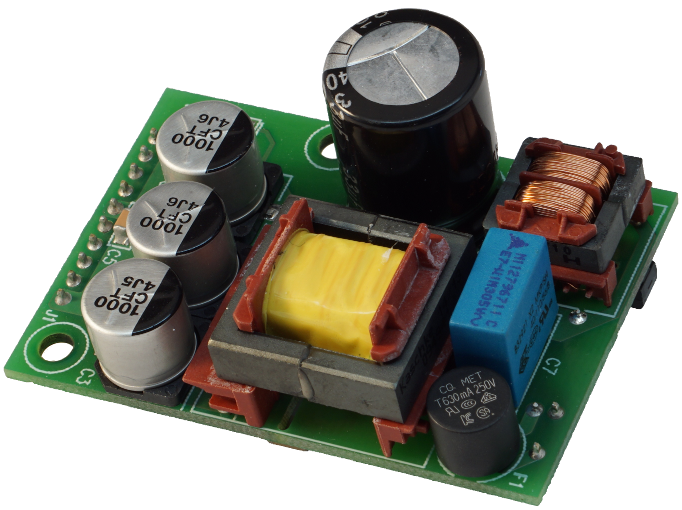GENERAL
The plug-ins are 40x60mm PCBs that are plugged into the DINGO Base Board (DBB) using 28 pin connectors plus optional 7 high voltage pin connector .
Plug-ins can have external contacts via the screw-connectors at the DBB. Openings for antennas can be either at the side just above the Base Board screw terminals or up through front panel of the boxing (applies only to station 3 of a 3 station DBB).
Third parties are welcome to design their own plug-ins for DINGO IoT Base Boards.
Image shows a 3-station Base Board with all three plug-in slots occupied. Front-most is an internal PSU plug-in. In the middle there is a PINGO plug-in for power-line communication. The third is a WINGO plug-in for low power, long range wireless communication.
This particular setup with one of the DINGO Computers on top, can easily bridge PINGO and WINGO communication.
GSM/3G PLUG-IN
The GSM/3G plug-in provides the DINGO BACKBONE with Internet
connection, whenever xDSL or similar is not available or prohibited because of security restrictions.
This plug-in can have "on box" antenna or external antenna, via a coax connector "on box".
With this plug-in it is easy to configure DINGO BACKBONE as an Internet gateway or hot-spot.
More about our wireless solutions here...
WINGO PLUG-IN
WINGO is our sub-1GHz wireless low power solution based on cutting edge technology from Texas Instruments.
This plug-in is mainly intended to allow DINGO BACKBONE to function as a kind of server for multiple WINGO BACnet enabled sensors connected on a 6LoWPAN network.
It can also be used to enable USB/RS32/RS485 pass-through over long distances via WINGO.
Thirdly it can be used to interconnect DINGO BACKBONES on a 6LoWPAN network, that is practical where Wi-Fi has range limitations.
Last this plug-in enables other network stacks like Wireless M-Bus.
More about DINGO Passthrough (item ID DINGO-PH-BB-01) here...
XBEE PLUG-IN
This plug-in enables DINGO BACKBONE to communicate with any XBee enabled device in the field.
We decided to provide this module first and foremost because of XBee immerse popularity, mainly in home-automation and lighting control.
We decided to provide this module first and foremost because of XBee immerse popularity, mainly in home-automation and lighting control.
The DINGO XBee plug-in is provided with a piggy backed XBee module. The XBee module can be any of the XBee or XBee PRO modules from DIGI.
Shown is the DINGO plug-in with XBee S1. We only sell the plug-in it self, excluding the XBee module. It is up to the customer to select any of DIGIs modules.
Shown is the DINGO plug-in with XBee S1. We only sell the plug-in it self, excluding the XBee module. It is up to the customer to select any of DIGIs modules.
PINGO PLUG-IN
We live in a very imperfect world. Sometimes there are dedicated wires for device communication. If not wireless communication can be used. Unfortunately wireless communication has limitations too. Building shadows, thick stone-walls and metal cabinets, can stop it. Interference and security can also be an issues.
Then the only communication media left is the existing power-wires in buildings and streets. Narrow-band Power Line Communication (N-PLC) has been known for decades, but also known for being unreliable and complex to use.
We have been using a little known N-PLC technology for over 10 years that stands out when it comes to reliability, range and noise immunity.
This plug-in implements that technology. DINGO software stack implements a so called APDU-to-APDU BACnet gateway for PINGO. By that, devices connected over the power-line ca be seen as BACnet devices. Thereby we hide the N-PLC complexity and make it transparent.
More about PINGO here...
More about DINGO APDU-to-APDU gateway here...
M-BUS PLUG-IN
M-Bus is a fast growing standard in Europe for reading consumption meters (heat, electricity, gas, etc.). To respond to that demand and enable DINGO IoT BACKBONE as a M-Bus concentrator, we have added this plug-in to the family of DINGO plug-ins.
- Fully Isolated Interface.
- ON Board 35V M-Bus interface.
- Connected via screw connectors on Base Board.
- Controlled by DINGO Computer, via TTL Serial I/F or USB I/F.
RS-485 PLUG-IN
This half/full duplex RS-485 plug-in is an addition to the half-duplex RS-485 (multi)port on the DINGO IoT Computers.
- Fully Isolated Interface.
- 120 ohm termination resistor switchable on TX and RX Pair.
- Connected via screw connectors on Base Board.
- Controlled by DINGO Computer module, via TTL serial I/F or USB I/F.
POWRE SUPPLY UNIT (PSU) PLUG-IN
This Power Supply Unit (PSU) plug-in is a mains 110VAC – 220VAC to 12VDC.
It can supply the DINGO BACKBONE with up to 1A DC current at 12VDC.
It can supply the DINGO BACKBONE with up to 1A DC current at 12VDC.
In many installations external PSU is not wanted. In that case it is very convenient to be able connecting the mains directly to the box via screw connectors at the DINGO BACKBONE high-voltage side.
NOTE: This PSU is designed to minimize noise and attenuation for PINGO communication. It is highly recommended to use this PSU when PINGO is also used (see PINGO plug-in above).
NOTE: This PSU is designed to minimize noise and attenuation for PINGO communication. It is highly recommended to use this PSU when PINGO is also used (see PINGO plug-in above).
ANALOG INPUT PLUG-IN
This plug-in is intended to add Analog Inputs to Base Boards not having those as standard IOs.
4 x ADC are available on screw connections at the Base Board
USB-BREAKOUT PLUG-IN
USB-Breakout is mainly intended for the DINGO Raspberry Pi Zero Computer module, for accessing its USB port. Raspberry Pi Zero has only one USB port that had to be feed down to the Base Board.
Usage example:
With this plug-in DINGO Pi Zero can be used as a desktop computer with keyboard and mouse.
Usage example:
With this plug-in DINGO Pi Zero can be used as a desktop computer with keyboard and mouse.


 Order now...
Order now...







